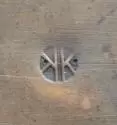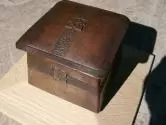Is It Morse Code – Or a Secret Roycroft Code?

Answer: When it’s a Roycroft dot.
Arts & Crafts furniture designer, craftsman and collector Robert Hause (http://www.artofthecraft.com) sent us photographs of an exquisitely-tooled, hand-hammered copper stamp box that looks very much like one you would expect to bear a Roycroft orb-and-cross shopmark.
Only this one didn’t.
Instead, it bore the back-to-back letter “Ks” of master coppersmith Karl Kipp, who both worked for the Hubbard family as foreman in the Roycroft Copper Shop and who owned, for a short time, his own East Aurora, NY, copper shop called the Tookay Shop (pronounced “two-kay,” like his shopmark).
Karl Kipp might have been a little more familiar to a larger number of Arts & Crafts collectors had he not stormed out of the Roycroft Copper Shop in 1912, reportedly after an argument with Alice Hubbard over his wages. Had he stayed he would also be remembered today as the designer of all of the lighting fixtures in the Grove Park Inn. Instead, that honor went to Victor Toothaker, who the Hubbards hired to fill Kipp’s vacancy.
Kipp took with him the Roycroft Copper Shop’s #2 master coppersmith – Walter U. Jennings, who Roycroft collectors know deserves far more credit, attention and research than he has been given.
Collectors also know that while Elbert Hubbard insisted that every piece of Roycroft copper be signed with the familiar orb-and-cross, he did not permit his talented craftsmen to also include their personal mark, as was the case, for instance, at Rookwood Pottery and Newcomb College Pottery.
Karl Kipp did on rare occasion stamp his initials beside the Roycroft mark, as did a few others. Walter Jennings applied his initials to pieces he made in his private workshop, but was not so obvious when it came to those pieces he made while employed by the Hubbards or Karl Kipp.
Researchers now believe that a single dot punched inside the Roycroft circle was made by Walter Jennings, perhaps in a semi-secret way of signing his work. Other pieces have surfaced with two dots punched inside the Roycroft shopmark, leading collectors to wonder if the two dots were left by Jennings or someone else at Roycroft.
On the copper stamp box pictured here that Robert Hause has found, the back-to-back “Ks” used in the Karl Kipp shop, where Jennings is known to have worked, are accompanied by two dots inside the box.
Which begs the question: were the double dots also a mark of Walter Jennings – or were they the mark of a yet-unidentified craftsman who worked for both Karl Kipp and for Elbert Hubbard?
Stay tuned – one of our readers may know the answer.
– Bruce Johnson

